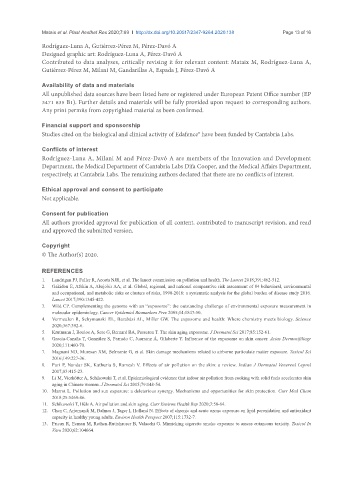Page 96 - Read Online
P. 96
Mataix et al. Plast Aesthet Res 2020;7:69 I http://dx.doi.org/10.20517/2347-9264.2020.138 Page 13 of 16
Rodríguez-Luna A, Gutiérrez-Pérez M, Pérez-Davó A
Designed graphic art: Rodríguez-Luna A, Pérez-Davó A
Contributed to data analyses, critically revising it for relevant content: Mataix M, Rodríguez-Luna A,
Gutiérrez-Pérez M, Milani M, Gandarillas A, Espada J, Pérez-Davó A
Availability of data and materials
All unpublished data sources have been listed here or registered under European Patent Office number (EP
3471 835 B1). Further details and materials will be fully provided upon request to corresponding authors.
Any print permits from copyrighted material as been confirmed.
Financial support and sponsorship
Studies cited on the biological and clinical activity of Edafence® have been funded by Cantabria Labs.
Conflicts of interest
Rodríguez-Luna A, Milani M and Pérez-Davó A are members of the Innovation and Development
Department, the Medical Department of Cantabria Labs Difa Cooper, and the Medical Affairs Department,
respectively, at Cantabria Labs. The remaining authors declared that there are no conflicts of interest.
Ethical approval and consent to participate
Not applicable.
Consent for publication
All authors provided approval for publication of all content, contributed to manuscript revision, and read
and approved the submitted version.
Copyright
© The Author(s) 2020.
REFERENCES
1. Landrigan PJ, Fuller R, Acosta NJR, et al. The lancet commission on pollution and health. The Lancet 2018;391:462-512.
2. Gakidou E, Afshin A, Abajobir AA, et al. Global, regional, and national comparative risk assessment of 84 behavioral, environmental
and occupational, and metabolic risks or clusters of risks, 1990-2016: a systematic analysis for the global burden of disease study 2016.
Lancet 2017;390:1345-422.
3. Wild CP. Complementing the genome with an “exposome”: the outstanding challenge of environmental exposure measurement in
molecular epidemiology. Cancer Epidemiol Biomarkers Prev 2005;14:1847-50.
4. Vermeulen R, Schymanski EL, Barabási AL, Miller GW. The exposome and health: Where chemistry meets biology. Science
2020;367:392-6.
5. Krutmann J, Bouloc A, Sore G, Bernard BA, Passeron T. The skin aging exposome. J Dermatol Sci 2017;85:152-61.
6. Gracia-Cazaña T, González S, Parrado C, Juarranz Á, Gilaberte Y. Influence of the exposome on skin cancer. Actas Dermosifiliogr
2020;111:460-70.
7. Magnani ND, Muresan XM, Belmonte G, et al. Skin damage mechanisms related to airborne particulate matter exposure. Toxicol Sci
2016;149:227-36.
8. Puri P, Nandar SK, Kathuria S, Ramesh V. Effects of air pollution on the skin: a review. Indian J Dermatol Venereol Leprol
2017;83:415-23.
9. Li M, Vierkötter A, Schikowski T, et al. Epidemiological evidence that indoor air pollution from cooking with solid fuels accelerates skin
aging in Chinese women. J Dermatol Sci 2015;79:148-54.
10. Marrot L. Pollution and sun exposure: a deleterious synergy. Mechanisms and opportunities for skin protection. Curr Med Chem
2018;25:5469-86.
11. Schikowski T, Hüls A. Air pollution and skin aging. Curr Environ Health Rep 2020;7:58-64.
12. Chen C, Arjomandi M, Balmes J, Tager I, Holland N. Effects of chronic and acute ozone exposure on lipid peroxidation and antioxidant
capacity in healthy young adults. Environ Health Perspect 2007;115:1732-7.
13. Prieux R, Eeman M, Rothen-Rutishauser B, Valacchi G. Mimicking cigarette smoke exposure to assess cutaneous toxicity. Toxicol In
Vitro 2020;62:104664.

